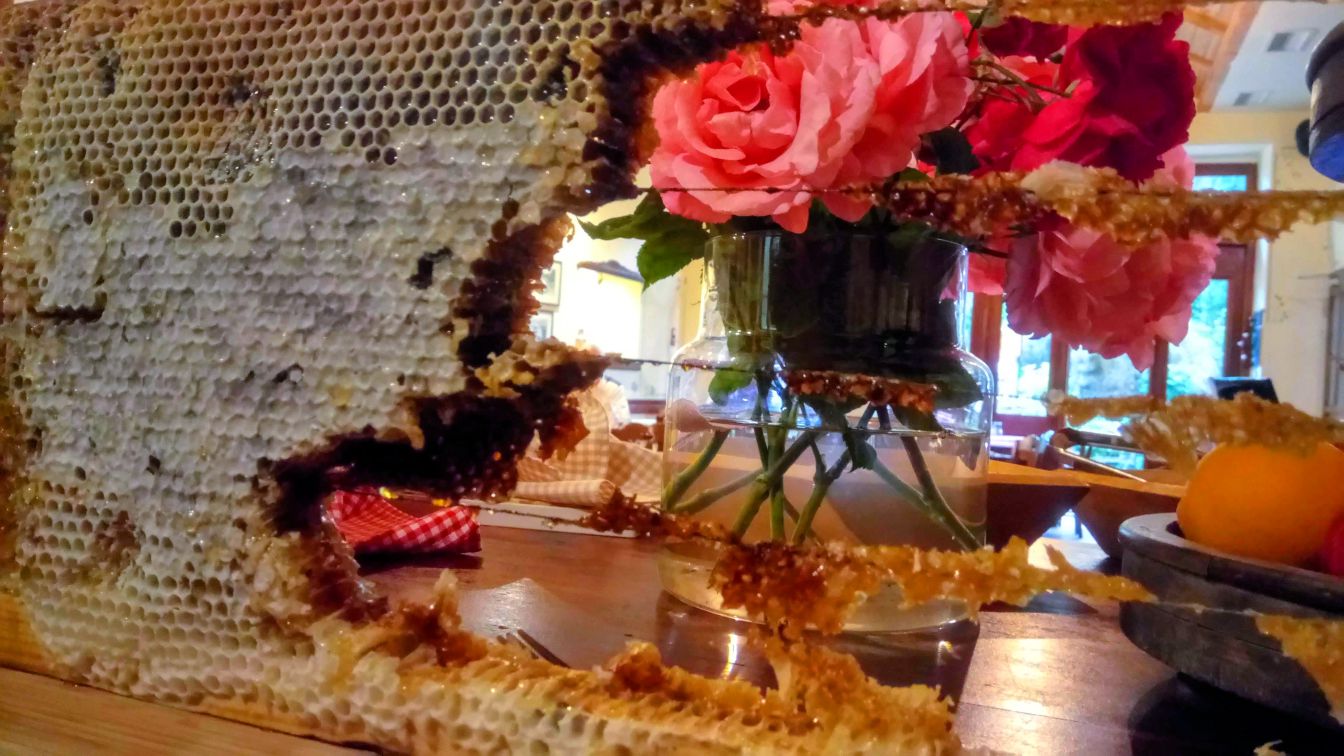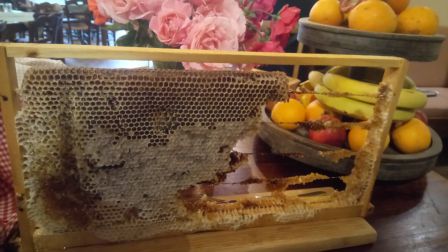Honey, the gift of the gods according to the ancient Greeks. Honey and the bee were protagonists in mythology. The god Apollo owed his dazzling beauty to the honey and ambrosia he fed on. Apollo's son, Aristaeus, who was made with the nymph Cyrene, became immortal because he was fed with honey nectar and ambrosia. Moreover, he was the first ancient figure who dealt with honey and beekeeping, hence he became the protector of honey.
Hippocrates used honey for the treatment of many diseases, while Aristotle believed that honey prolongs life. A symbol of fertility, happiness, and well-being.
The process of making honey is as follows: After bees collect nectar from the plant, it goes through a special process in their bodies and their secretions from the prolobus transform it into honey, which they deposit in the cells (frames) of the honeycomb inside their beehive. There, they dehydrate it by reducing its moisture to as low as 18%. Once it has matured, they seal it with wax so it can be preserved.
Then it's time to collect the honey, which is done when the moisture level is between 14%-18%. If the moisture is higher than 18%, our honey is at serious risk of spoiling.
Pure honey, not adulterated, can be simply identified in the following way: In a glass of water, drop a spoonful of honey. Without stirring it, pure honey will sit at the bottom of the glass unchanged. If it contains syrup, we will slowly see it dissolve on its own.
When honey crystallizes, it doesn't mean it's adulterated as some think, nor if it is thick. Crystallized honey is due to its glucose content from the composition of the honey, as we will see below in the types of honey. The safest way is to slowly bring it back in a bain-marie but not exceeding 35o -40o degrees (that's also why it's not good to put honey in hot beverages. The correct way is to let the temperature of the drink drop so as not to lose the beneficial ingredients of the honey. If we add honey directly into hot water, all we achieve is to sweeten our drink) or on top of a radiator. Never in the sun because it will destroy its beneficial ingredients.
Honey is properly preserved in a shady and cool place. An open jar for a long time spoils because it absorbs the humidity of the air and changes its antibacterial properties. It is therefore good to use it within a short period after opening it to have all its nutritional ingredients. And let's not forget that honey has been found in tombs and shipwrecks that date back thousands of years before. And this is due to its airtight sealing.
There are monofloral honeys, which we get the nutritional properties from a single plant that the bee has collected from. However, it's a bit difficult to do this, but not impossible.
In Greece, more and more beekeepers are trying to produce organic honey. The honey that has not used any chemical formulation inside and outside the beehive. This is quite difficult because we cannot have full control of where the bee goes, which areas it is in (polluting up to 4 kilometers, etc.), what plants it has gone to, if they are sprayed, even if the beehive has been painted.
Pure, unadulterated honey can be obtained from producers, taking care to know the honey we will buy, first by its color and smell, verifying its reliability with a taste test.
Let's take a look at some types of honey:
Acacia Honey
Acacia honey is light and almost transparent in color. It has beneficial properties for cleansing the liver, calming the nervous system, thus aiding in combating insomnia, stress, and anxiety. It helps with respiratory system diseases and intestinal function. It is considered one of the therapeutic honeys and can be consumed in small quantities by diabetics. It is recommended for children and the elderly.
Flower Honey
Flower honey has the sweetest taste among all honeys. It is light-colored and has a smooth taste. It crystallizes relatively quickly due to its high glucose content. The crystallization of honey is natural, and it does not affect the honey's nutritional and biological value. A crystallized honey is neither adulterated nor spoiled. We can return it to a liquid state by gently warming it in a bain-marie.
Heather Honey
Heather honey is considered one of the rare honeys because bees find it difficult to penetrate the narrow calyx of the heather flower to collect the nectar. Thus, in their effort to collect the nectar, they become exhausted and weakened. Heather honey is primarily produced in Epirus, Greece, because heather grows in rocky and stony soils. Hence, in addition to the difficulties of the bees, the quantity is also challenging as it is not produced every year. It has a yellowish, thick consistency with a strong and distinctive taste. It strengthens the body, revitalizes, and combats the feeling of physical fatigue.
Fir Honey
Fir honey is one of the most widespread honeys produced in our country. It is produced in areas like Mount Olympus, Evritania, Pertouli, Taygetos, and in many other regions of Greece. The fir is considered the most important honey-producing plant in Greece. It is the honey that the elderly prefer due to its low sugar content. It crystallizes slowly because of its low glucose content. It is considered a honey of high nutritional value due to the large number of different substances in its composition. Rich in minerals (magnesium, zinc, copper, iron, etc.), it helps with cough and uric acid arthritis. It is also an excellent remedy for throat conditions. It reduces ulcer problems, aids in constipation, and is recommended for people with diabetes, athletes, and children.
Orange Blossom Honey
Orange blossom is a significant source of nectar. A rare honey, it is particularly aromatic, providing an intense and wonderful fragrance. Its taste is especially sweet, making it more popular among children. Thus, it crystallizes very quickly and is recommended to be consumed within a short period. It is a source of energy for the human body, with carbohydrates in the form of glucose, fructose, and sucrose. Contains minerals and trace elements. Calcium, potassium, copper, antioxidants, has precious antibacterial, anti-aging, and anti-cancer properties. It helps the immune system and combats pathogenic microorganisms, providing protection against oxidative damage to the DNA molecules of cells.
Pine Honey
The pine is considered the most significant honey-producing plant in Greece. Major productions of pine honey are in Northern Evia, Halkidiki, Thasos, Skopelos, Zakynthos, and Rhodes. Pine honey accounts for 65% of the total honey production in Greece. It is the honey preferred by the elderly due to its low sugar content. It crystallizes slowly due to its low glucose content. It is considered a honey of high nutritional value because it contains a large number of different substances. Rich in minerals, it helps with coughs and uric acid arthritis. It also makes an excellent remedy for throat conditions. It lowers cholesterol, aids the urinary and digestive systems, and is recommended for people with diabetes, athletes, and children.
Sunflower Honey
Sunflower honey is readily produced as sunflowers abundantly provide nectar during the summer months. However, during the nectar collection in summer, the collector bees become exhausted and suffer from melanization. They lose their hair and become black. For this reason, beekeepers do not allow sunflowers near their beehives for extended periods. In Greece, it's mainly produced in Northern Greece, Macedonia, Thrace, and Evros. The honey from sunflowers is golden-yellow with a full taste, fluid, and one of the most common honeys available in commerce.
Thyme Honey
One of the highest quality honeys produced in our country. It falls under floral honeys but is a special category due to its intense aromas and flavor characteristics. It is the most commonly preferred honey by consumers. The production of thyme honey accounts for about 10% of Greece's total honey production. The main areas of thyme honey production in Greece are the islands, especially Crete and Kythira.
Its flavor is strong, and in some cases, due to high fructose content, it leaves a slight burning sensation in the mouth. It is intensely aromatic honey, with an amber color, though it varies by region (orange in Crete, lighter in Attica and the Cyclades).
It has tonic and antiseptic properties, rich in phosphorus, magnesium, and iron.
Recommended for children and is the number one choice during periods of colds and viruses.
Chestnut Honey
Produced from the honeydew secretions of the chestnut tree. It is produced in the mountainous regions of Greece and is mainly collected in the Mount Athos peninsula and is limited in production. The taste of chestnut honey is very intense and slightly bitter. The color ranges from light to dark brown, and due to its low sugar content, it crystallizes after 1-2 years. It has significant antibacterial activity against various microorganisms, such as staphylococcus, enterococcus, helicobacter pylori, and candida species. It also has a high antibacterial activity such that in some areas it is used to cover chronic wounds, burns, and skin ulcers. It boosts mental clarity, helps with pregnancy and venous insufficiency.
Rich in minerals, it is recommended for the elderly and babies, for athletes, and for those with prostate issues and diabetes.
Orange Blossom Honey
Orange blossom is an important source of nectar. It is a rare honey, highly aromatic with an intense and lovely scent. The taste is exceptionally sweet, making it more favored by children. Thus, it crystallizes very quickly and is recommended for consumption within a short time span. It is a source of energy for the human body, with carbohydrates in the form of glucose, fructose, and sucrose. Contains minerals and trace elements. It has valuable antibacterial, anti-aging, and anti-cancer properties. It aids the immune system and the fight against pathogenic microorganisms, offering protection from oxidative damage to the DNA molecules in cells.
arbutus honey
The arbutus tree is considered the most significant apicultural plant in Greece. Major production areas of pine honey include Northern Evia, Halkidiki, Thasos, Skopelos, Zakynthos, and Rhodes. Pine honey constitutes 65% of the total honey production in Greece. It's the honey preferred by the elderly due to its low sugar content. It crystallizes slowly because of its low glucose content. Considered high in nutritional value, it's rich in minerals and helps with coughs and uric acid arthritis. Also, it's an excellent remedy for throat conditions, reduces ulcer issues, aids constipation, and is recommended for people with diabetes, athletes, and children.
LATEST RECIPES
GET LATEST UPDATES
Newsletter Subscribe
FEATURED ARTICLE

GET LATEST UPDATES
Newsletter Subscribe























































































